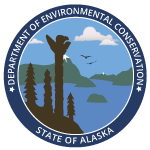Alaska State Revolving Fund's Frequently Asked Questions
This page contains answers to frequently asked questions (FAQs) related to the Alaska State Revolving Fund Program (SRF) and the Online Application System (OASys) that is used to submit questionnaires, loan applications, disbursement requests, quarterly reports, and the Disadvantaged Business Enterprise (DBE) annual report.
For additional questions or assistance, please send an email to: dec.srfprogram@alaska.gov
Click question to show answer.
Frequently Asked Questions about the State Revolving Fund Program
- What funding sources are available through the SRF Program?
- In addition to the traditional Clean Water State Revolving Fund (CWSRF) and Drinking Water State Revolving Fund (DWSRF) loans available each year (Base Fund), new funding opportunities established through the Bipartisan Infrastructure Law (BIL) will be available, including:
• CWSRF and DWSRF BIL General Supplemental Funds
• CWSRF and DWSRF BIL Emerging Contaminant Funds - What projects are eligible for financing through the SRF Program?
- Eligible projects include drinking water and wastewater planning, design, and infrastructure construction projects, such as distribution and collection system improvements, treatment system upgrades, water and energy efficiency improvements, and security enhancements. In addition, nonpoint source projects may be eligible including source water protection efforts, water body restoration, storm water improvements, landfill closure, and harbor or dock waste handling. Eligible projects under the Emerging Contaminant funding may include water system consolidation, water treatment process improvements, wastewater treatment plant improvements, or non-point source water remediation.
- How do I prepare and submit a questionnaire?
- Questionnaires must be submitted online through the Online Application System (OASys). After you log into OASys, click on the State Revolving Fund tab and select the type of questionnaire that fits your project: drinking water, clean water (wastewater), or nonpoint source. A step-by-step guide provides assistance in navigating the online questionnaire process.
- How are projects reviewed and scored after questionnaire submittal?
- Following the February 28th, June 30th, October 31st submittal deadlines, all submitted project questionnaires will be scored based on established criteria which can be found on the Questionnaire Process webpage. After review and scoring questionnaires, eligible projects will be added to the updated Project Priority Lists (PPL).
- My project is already listed on the PPL. Do I need to submit another questionnaire to be eligible for the BIL funding?
- Projects previously submitted to the SRF Program may remain on the PPL for two years. All projects currently on the PPLs that are within that two-year timeframe will be considered for financing with SRF Base funding and/or BIL funds. If the proposed scope of work associated with a project has changed since the questionnaire was originally submitted, or if the cost of the project has increased, then a new questionnaire should be submitted to reflect the correct scope and cost. If the project has not resulted in a loan agreement after two years on the PPL, the project will be deleted from the list unless a new questionnaire is submitted.
- How will Base Funds and BIL Funds be allocated to the projects on the PPL?
- The Emerging Contaminants funds may only be used to fund projects targeting those specific issues. Both Base Funds and BIL General Supplemental Funds may be used for any SRF eligible project. Where appropriate to meet the needs of our customers, a combination of these funding sources may be awarded in a loan package.
- How much principal forgiveness will my project be eligible to receive?
- Eligibility for principal forgiveness will depend in part on the type of project being financed. Eligibility for principal forgiveness also depends on whether the borrower meets the criteria as a disadvantaged community.
- How do I know if my community is considered a disadvantaged community?
- Please see the current Intended Use Plan for information about disadvantaged community criteria. If you do not see your community listed, please contact us at dec.srfprogram@alaska.gov to have us complete an analysis. A key priority of BIL is to ensure that disadvantaged communities benefit equitably from this investment in water infrastructure. The BIL mandates that 49% of funds provided through the CWSRF and DWSRF General Supplemental Funding must be provided as forgivable loans to disadvantaged communities. This does not mean that 49% of every loan agreement will be forgiven. Some projects may receive more principal forgiveness, and some less.
- What happens after I submit a project questionnaire and my project is added to the PPL?
- After a project is added to the PPL, the applicant can then prepare and submit a loan application for review. The SRF Program will then review the application materials and complete a financial capacity assessment to determine the borrower’s ability to operate and maintain the system and also repay the loan. The SRF Program will also complete an environmental review of the proposed project. If all loan application requirements are met, a loan agreement will be drafted and offered to the borrower. For more information please check the Loan Process webpage.
- Is submitting a project questionnaire considered a commitment to move forward with a loan application?
- No. Submitting a questionnaire is not an obligation to apply for a loan and neither is it a guarantee of funding.

 Indicates an external site.
Indicates an external site.